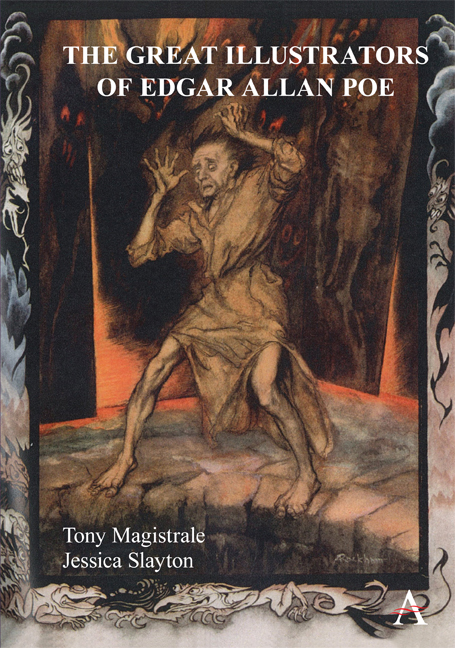4 - A Parergon for Poe: Arthur Rackham’s Illustrations
Published online by Cambridge University Press: 04 June 2021
Summary
British Modernist illustrator Arthur Rackham was influenced by Baudelaire, the French Symbolist poets, and particularly the French illustrators from the nineteenth century; like these predecessors, Rackham eventually turned to Edgar Allan Poe's texts as subject material for his art. Rackham's images of Poe were published after The Great War and thus captured some of the violence evinced in the deaths of 16 million people, while leaving millions more maimed and mentally broken. Entirely new ways of thinking about war had to be invented, and artists could not ignore its global impact. As a result, Rackham's art took part in emphasizing forms of the grotesque and mental illness, as did the Decadents— Clarke and Beardsley, for example— before him, but moved further in expressing the true horror of death, torture, and the futility and meaninglessness of human endeavors. Like theirs, his work was human-centric, but with an underlined emphasis on the perpetuation of intentional violence. Though always a book illustrator rather than a participant in “high art,” who, in addition to his drawings of Poe, is perhaps most famous for his whimsical illustrations of fairy tales, Rackham lived in the modern world where ideological realism as represented through alternative artistic avenues— Surrealism, Cubism, Dadaism— was valued; illustration, an inherently non-stand-alone medium of art, also advanced as an alternative avenue of expression with the advent of Modernism. With Braque and Picasso's experiments in collage and other nontraditional forms of representation dominating the art scene in the first two decades of the twentieth century, appreciation for a broader range of pictorial art expanded. Rackham's focus on the Poe tales emphasized their violence rather than the phantasmagorical environmental atmospheres found in illustrators such as Doré, or the sexual deviance of Beardsley. In this way, it is clear that Rackham builds upon the line of Poe illustration we first advanced in Chapter 2, most specifically seen in Martini and Becher, and later in Chapter 3, with Beardsley and Clarke.
In fact, Burton Pollin rightly references Rackham's work as “the last exhibition of true artistry in the illustration of Poe from the entire British school of the present century” (Pollin 10).
- Type
- Chapter
- Information
- The Great Illustrators of Edgar Allan Poe , pp. 127 - 156Publisher: Anthem PressPrint publication year: 2021



